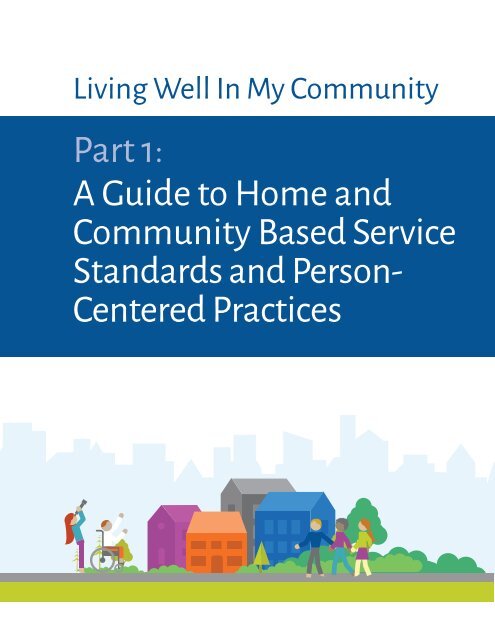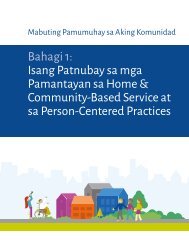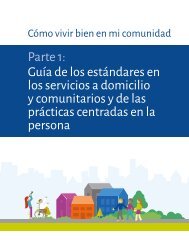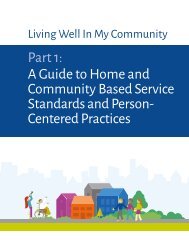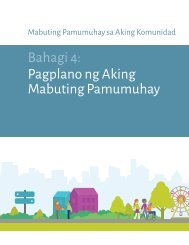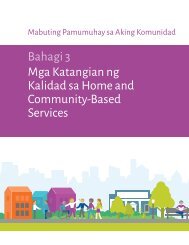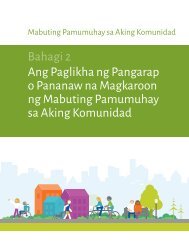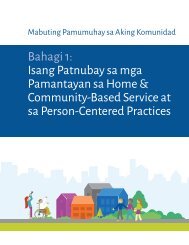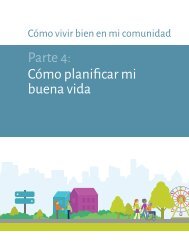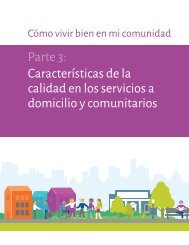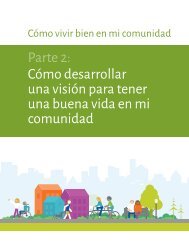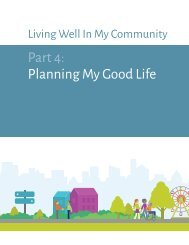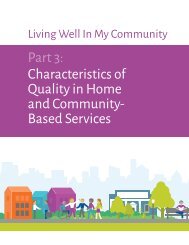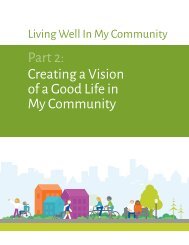Living Well In My Community Part 1 - A Guide to Home and Community-Based Service Standards and Person-Centered Practices
You also want an ePaper? Increase the reach of your titles
YUMPU automatically turns print PDFs into web optimized ePapers that Google loves.
<strong>Living</strong> <strong>Well</strong> <strong>In</strong> <strong>My</strong> <strong>Community</strong><br />
<strong>Part</strong> 1:<br />
A <strong>Guide</strong> <strong>to</strong> <strong>Home</strong> <strong>and</strong><br />
<strong>Community</strong> <strong>Based</strong> <strong>Service</strong><br />
St<strong>and</strong>ards <strong>and</strong> <strong>Person</strong>-<br />
<strong>Centered</strong> <strong>Practices</strong>
How <strong>to</strong> use <strong>Living</strong> <strong>Well</strong> <strong>In</strong> <strong>My</strong> <strong>Community</strong><br />
Feel free <strong>to</strong> download this guide <strong>to</strong> use <strong>and</strong> share with<br />
others. <strong>Living</strong> <strong>Well</strong> <strong>In</strong> <strong>My</strong> <strong>Community</strong> was created <strong>to</strong><br />
help people with disabilities <strong>and</strong> service providers<br />
better underst<strong>and</strong> the rights <strong>and</strong> roles for living well<br />
in the community. <strong>Part</strong> 1 explains what the <strong>Home</strong> <strong>and</strong><br />
<strong>Community</strong>-<strong>Based</strong> <strong>Service</strong>s Rule is <strong>and</strong> how it can help<br />
people with disabilities <strong>to</strong> live in the community like other<br />
people without disabilities.<br />
<strong>In</strong> <strong>Part</strong> 2, resources from Charting the Life Course can be<br />
used <strong>to</strong> create a vision of a good life in the community.<br />
<strong>Part</strong> 3 describes each characteristic of quality home <strong>and</strong><br />
community-based services with some reflective questions<br />
<strong>to</strong> assess progress <strong>and</strong> areas for continued development.<br />
Examples of some person-centered approaches are<br />
introduced <strong>to</strong> help individuals with disabilities <strong>and</strong><br />
providers move in the direction of a person’s vision of a<br />
good life. The person-centered approaches described<br />
in <strong>Living</strong> <strong>Well</strong> <strong>In</strong> <strong>My</strong> <strong>Community</strong> will also be helpful <strong>to</strong><br />
providers in meeting the home <strong>and</strong> community-based<br />
settings requirements. <strong>Part</strong> 4 has useful tips for working<br />
with a planning team <strong>to</strong> support a vision of a good life<br />
through person-centered planning, as well as an array of<br />
resources for more information.<br />
HCBS Peer <strong>Part</strong>ners Project Grant<br />
The workbook is funded by a grant from the California<br />
Department of Developmental <strong>Service</strong>s. UCP WORK, <strong>In</strong>c. is<br />
the lead agency, representing a regional project reflecting<br />
efforts of multiple providers that support individuals <strong>and</strong><br />
families in the Tri-Counties Regional Center catchment<br />
area. This includes UCP-LA <strong>and</strong> Villa<br />
Esperanza in Ventura County, UCP WORK, <strong>In</strong>c., CPES/<br />
Novelles, <strong>and</strong> Devereux in Santa Barbara <strong>and</strong> San Luis<br />
Obispo Counties. An ad hoc subcommittee of the TCRC<br />
Vendor Advisory Committee, comprised of service<br />
providers, regional center staff, <strong>and</strong> representation from<br />
the State Council on Developmental Disabilities (SCDD),<br />
implemented a survey of regional service providers. Upon<br />
reviewing results, the survey revealed a gap in getting<br />
HCBS information as well as <strong>Person</strong>-<strong>Centered</strong> Thinking<br />
resources <strong>to</strong> providers in outlying areas operating a small<br />
business which serve individuals <strong>and</strong> families.<br />
The impetus for the efforts of the grant project is in aiding<br />
providers <strong>to</strong> underst<strong>and</strong> how <strong>to</strong> meet the new HCBS<br />
Waiver <strong>Community</strong> St<strong>and</strong>ards. The greater goal of the<br />
st<strong>and</strong>ards <strong>and</strong> this grant project is <strong>to</strong> support persons<br />
with developmental disabilities <strong>to</strong> have better lives, not<br />
just better paper. We endeavor <strong>to</strong> give the people we<br />
support more control over their services, receiving what is<br />
important <strong>to</strong> them: services supporting their own vision<br />
for the future <strong>and</strong> what is important for <strong>to</strong> be healthy, safe<br />
valued, members of their community.<br />
Acknowledgments<br />
Thank you <strong>to</strong> the many contribu<strong>to</strong>rs who<br />
helped in creating this guide<br />
HCBS Peer <strong>Part</strong>ner Advisory Committee<br />
Dave Mulvey, HCBS Peer <strong>Part</strong>ners Project<br />
Coordina<strong>to</strong>r<br />
Diva Johnson, Tri-Counties Regional<br />
Center<br />
Harry Bruell, PathPoint<br />
Judy Linares, UCP Work <strong>In</strong>c.<br />
Kathy Webb, UCP Work <strong>In</strong>c.<br />
Mark O’Keefe, Tri-Counties Regional<br />
Center<br />
Mary Beth Lepkowsky, Helen S<strong>and</strong>erson<br />
Associates USA<br />
Michele Ferrall, CPES/Novelles<br />
Nikisa Simmons UCP-LA<br />
Tina Calderaro-Mendoza, Tri-Counties<br />
Regional Center<br />
<strong>Living</strong> <strong>Well</strong> <strong>In</strong> <strong>My</strong> <strong>Community</strong> was<br />
funded by a grant from the California<br />
Department of Developmental<br />
<strong>Service</strong>s <strong>and</strong> includes principles <strong>and</strong><br />
concepts developed by <strong>and</strong> used here<br />
with permission from The Learning<br />
<strong>Community</strong> for <strong>Person</strong>-<strong>Centered</strong> <strong>Practices</strong>.<br />
http://tlcpcp.com/<br />
S<strong>to</strong>ries <strong>and</strong> examples were contributed<br />
by Sue Goss, Diva Johnson, Rebecca<br />
Martinez, David Mulvey, Valerie Nix,<br />
Michael Kaszycki, Derek Smith <strong>and</strong> Mary<br />
Beth Lepkowsky. Others were generous<br />
in giving permission <strong>to</strong> share a variety of<br />
person-centered resources.<br />
Helen S<strong>and</strong>erson Associates USA<br />
https://helens<strong>and</strong>ersonassociates.com<br />
John O’Brien <strong>and</strong> Beth Mount<br />
http://www.inclusion.com/<br />
bkmakeadifference.html<br />
Line Plourde-Kelly Kapuskasing &<br />
District Association for <strong>Community</strong><br />
<strong>Living</strong> (KDACL)<br />
http://www.kdacl.com<br />
Charting the Lifecourse<br />
https://www.lifecourse<strong>to</strong>ols.com<br />
Edi<strong>to</strong>rs: Mary Beth Lepkowsky, Dave<br />
Mulvey, Eugene Baldwin<br />
Translations: <strong>In</strong>line Translation <strong>Service</strong>s.<br />
Design: Julie Barclay<br />
May 2020<br />
1.2 <strong>Living</strong> <strong>Well</strong> <strong>In</strong> <strong>My</strong> <strong>Community</strong>
Contents<br />
<strong>Part</strong> 1: Overview of <strong>Home</strong> <strong>and</strong> <strong>Community</strong>-<br />
<strong>Based</strong> <strong>Service</strong>s <strong>and</strong> <strong>Person</strong>-<strong>Centered</strong> <strong>Practices</strong>.<br />
What is HCBS?.....................................................1.4<br />
What is the <strong>Home</strong> <strong>and</strong> <strong>Community</strong>-<strong>Based</strong><br />
<strong>Service</strong>s Waiver?..................................................1.4<br />
What is the HCBS Rule? Why is it needed?........1.4<br />
What does the HCBS Rule mean for people?.... 1.5<br />
• For people with disabilities............................ 1.5<br />
• For service providers....................................... 1.5<br />
What are the qualities of home <strong>and</strong><br />
community-based settings?...............................1.6<br />
How can person-centered thinking,<br />
planning <strong>and</strong> practices help?.............................. 1.7<br />
<strong>Part</strong> 2: Creating a Vision of a Good Life in <strong>My</strong><br />
<strong>Community</strong><br />
Having Choice <strong>and</strong> Control <strong>In</strong> <strong>My</strong> Life<br />
• Skill: Important To <strong>and</strong> For.............................2.3<br />
• Skill: One Page Profile.....................................2.7<br />
<strong>My</strong> Vision of a Good Life <strong>In</strong> <strong>My</strong> <strong>Community</strong><br />
• Skill: Tool for Creating a Vision..................... 2.11<br />
• Skill: LifeCourse Trajec<strong>to</strong>ry........................... 2.15<br />
<strong>Part</strong> 3: Characteristics of Quality in <strong>Home</strong> <strong>and</strong><br />
<strong>Community</strong>-<strong>Based</strong> <strong>Service</strong>s<br />
Quality Requirements.........................................3.3<br />
Being <strong>Part</strong> of the <strong>Community</strong>.............................3.3<br />
• Skill: Gifts <strong>and</strong> Capacities...............................3.4<br />
• Skill: <strong>Community</strong> Mapping............................3.7<br />
• Skill: What Happens Here............................3.10<br />
• Skill: Presence <strong>to</strong> Contribution..................... 3.13<br />
Choosing Where <strong>and</strong> How <strong>to</strong> Live.................... 3.16<br />
• Skill: Decision Making Profile...................... 3.17<br />
• Skill: Decision Making Agreement............. 3.20<br />
Having Privacy, Dignity <strong>and</strong> Respect................3.22<br />
• Skill: Communication Chart.........................3.23<br />
• Skill: Routines <strong>and</strong> Rituals............................3.26<br />
• Skill: Learning Log.........................................3.29<br />
<strong>In</strong>dependence...................................................3.32<br />
• Skill: Good Days / Bad Days.......................... 3.33<br />
• Skill: Perfect Week........................................3.36<br />
Choosing Supports <strong>and</strong> Who Provides Them.....3.38<br />
• Skill: Matching..............................................3.39<br />
• Skill: Donut Sort............................................3.43<br />
Additional Considerations for Residential<br />
Providers........................................................... 3.46<br />
• Skill: 4+1 Questions.......................................3.47<br />
• Skill: <strong>Person</strong>-centered Approach <strong>to</strong> Risk...... 3.51<br />
<strong>Part</strong> 4: Planning <strong>My</strong> Good Life<br />
Working With a Planning Team........................ 4.5<br />
• Skill: Relationship Map.................................. 4.5<br />
<strong>Person</strong>-centered Planning................................ 4.11<br />
• Skill: What’s Working / Not Working........... 4.11<br />
<strong>Community</strong> Building Checklist........................ 4.15<br />
Resources...........................................................4.19<br />
A <strong>Guide</strong> <strong>to</strong> <strong>Home</strong> <strong>and</strong> <strong>Community</strong> <strong>Based</strong> <strong>Service</strong> St<strong>and</strong>ards <strong>and</strong> <strong>Person</strong>-<strong>Centered</strong> <strong>Practices</strong> 1.3
What is HCBS?<br />
What are home <strong>and</strong> community-based<br />
services (HCBS)?<br />
HCBS st<strong>and</strong>s for <strong>Home</strong> <strong>and</strong> <strong>Community</strong>-<br />
<strong>Based</strong> <strong>Service</strong>s. <strong>Home</strong> <strong>and</strong> community- based<br />
services include different kinds of long-term<br />
services <strong>and</strong> supports that help people with<br />
disabilities <strong>and</strong> older adults live everyday lives<br />
in their communities.<br />
Some examples of long-term services <strong>and</strong><br />
supports are:<br />
• Adult day services.<br />
• Job coaches.<br />
• <strong>Person</strong>al care services <strong>to</strong> help with day<br />
<strong>to</strong> day activities like eating, bathing, <strong>and</strong><br />
getting dressed.<br />
Medicaid is a program of the United States<br />
federal government that helps people get<br />
health care if they don’t have a lot of money.<br />
Lots of people with disabilities use Medicaid.<br />
<strong>In</strong> California, the Medicaid program is called<br />
MediCal.<br />
Medicaid pays for long-term services <strong>and</strong><br />
supports. Some service providers get money<br />
from Medicaid <strong>to</strong> deliver long term services<br />
<strong>and</strong> supports.<br />
When people get long term services <strong>and</strong><br />
supports in their community, it is called home<br />
<strong>and</strong> community-based services (HCBS).<br />
<strong>Home</strong> <strong>and</strong> community-based settings are<br />
places where individuals with disabilities live<br />
<strong>and</strong> spend their days; for example, licensed<br />
residential settings <strong>and</strong> day programs. When<br />
Medicaid pays for home <strong>and</strong> communitybased<br />
services, it helps people with disabilities<br />
live in their communities. It helps people<br />
with disabilities live the same kind of lives as<br />
everyone else.<br />
What is the <strong>Home</strong> <strong>and</strong><br />
<strong>Community</strong>-<strong>Based</strong> <strong>Service</strong>s<br />
Waiver?<br />
Medicaid used <strong>to</strong> not pay for home <strong>and</strong><br />
community-based services. People could only<br />
get services in institutions. <strong>In</strong> California some<br />
institutions are called developmental centers.<br />
<strong>In</strong> the 1980’s the U.S. government wrote a<br />
“waiver” <strong>to</strong> change the law. The <strong>Home</strong> <strong>and</strong><br />
<strong>Community</strong> <strong>Based</strong> <strong>Service</strong>s Waiver changed<br />
the law <strong>to</strong> let Medicaid pay for services at<br />
home or in the community, not only in<br />
institutions or developmental centers.<br />
What is the HCBS Rule? Why<br />
is it needed?<br />
Medicaid started paying for home <strong>and</strong><br />
community-based services. But, nobody<br />
decided what would be different about<br />
services provided at home or in the<br />
community rather than in an institution.<br />
The HCBS Rule was created <strong>to</strong> explain what<br />
home <strong>and</strong> community-based services should<br />
look like, <strong>and</strong> what they shouldn’t look like.<br />
It makes sure Medicaid doesn’t give HCBS<br />
money <strong>to</strong> programs <strong>and</strong> services that are<br />
really more like institutions.<br />
The HCBS Rule helps people with disabilities<br />
live in their communities. It helps them get<br />
the kind of services they need. And it helps<br />
make sure home <strong>and</strong> community- based<br />
services really are HCBS <strong>and</strong> not like an<br />
institution.<br />
The HCBS Rule also says that all services<br />
in every state must follow the new rules by<br />
March 2022. After March 2022, the federal<br />
government will not pay service providers that<br />
do not meet the new rules.<br />
<strong>Living</strong> <strong>Well</strong> <strong>In</strong> <strong>My</strong> <strong>Community</strong>, <strong>and</strong><br />
information provided by HCBS Peer <strong>Part</strong>ners,<br />
the regional center, <strong>and</strong> the Department of<br />
1.4 <strong>Living</strong> <strong>Well</strong> <strong>In</strong> <strong>My</strong> <strong>Community</strong>
Developmental <strong>Service</strong>s can help individuals<br />
with disabilities <strong>and</strong> service providers<br />
underst<strong>and</strong> the new rules <strong>and</strong> make changes<br />
<strong>to</strong> give people more choice <strong>and</strong> control in<br />
their lives, <strong>and</strong> also meet the 2022 deadline.<br />
What does the HCBS Rule<br />
mean for people?<br />
The purpose of the HCBS Rule is <strong>to</strong> help<br />
people who receive regional center services<br />
live full lives in their communities. It helps<br />
people with disabilities live the same kind of<br />
lives as everyone else.<br />
For people who receive home <strong>and</strong><br />
community-based services:<br />
The HCBS Rule says that people with<br />
disabilities have different options <strong>to</strong> choose<br />
from when making decisions about services<br />
<strong>and</strong> service providers. The HCBS Rule says<br />
people with disabilities have the right <strong>to</strong>:<br />
• Live in the community along with people<br />
without disabilities.<br />
• Have a person-centered plan.<br />
• Have freedom.<br />
• Have respect <strong>and</strong> privacy.<br />
• Not be restrained or secluded.<br />
For service providers<br />
Some service providers may already meet<br />
the home <strong>and</strong> community-based services<br />
requirements. Others may find they need<br />
<strong>to</strong> modify policies <strong>and</strong> program designs,<br />
where <strong>and</strong> how services are delivered, <strong>and</strong><br />
provide training <strong>to</strong> assure that staff members<br />
underst<strong>and</strong> the expectations of the rules.<br />
The HCBS Rules says that providers have<br />
responsibilities for:<br />
• Ensuring that people with intellectual/<br />
developmental disabilities are provided<br />
the protections that are afforded <strong>to</strong> all<br />
California tenants, commonly known as<br />
“Tenant’s Rights”<br />
• Ensuring that people are treated with<br />
respect <strong>and</strong> are afforded privacy.<br />
• Supporting people in creating schedules<br />
that meet their needs <strong>and</strong> promote the<br />
lives they want <strong>to</strong> live.<br />
• Ensuring the people have opportunities <strong>to</strong><br />
have visi<strong>to</strong>rs.<br />
• Ensuring that a person’s home is accessible<br />
<strong>to</strong> them throughout the day.<br />
Remember, this is a partnership. Everyone<br />
wants <strong>to</strong> have good experiences in their<br />
community. People with disabilities, planning<br />
team members, service providers, family<br />
members, <strong>and</strong> regional center partners<br />
can work <strong>to</strong>gether <strong>to</strong> help everyone have<br />
good experiences. Use the person-centered<br />
practices described in this guide <strong>to</strong> make<br />
meaningful choices <strong>and</strong> changes. This will<br />
help <strong>to</strong> ensure that people live well in their<br />
community <strong>and</strong> providers continue <strong>to</strong> receive<br />
federal funding for offering high quality home<br />
<strong>and</strong> community-based services.<br />
What does the HCBS Rule say<br />
about home <strong>and</strong> communitybased<br />
services?<br />
The HCBS Rule says that home <strong>and</strong><br />
community-based services must be provided<br />
in the community. That means people with<br />
intellectual/developmental disabilities have<br />
the right <strong>to</strong> live in the community just like<br />
people without disabilities.<br />
<strong>Home</strong> <strong>and</strong> <strong>Community</strong>-<strong>Based</strong> Settings<br />
Requirements Compliance Toolkit<br />
https://www.medicaid.gov/medicaid/homecommunity-based-services/guidance/homecommunity-based-settings-requirementscompliance-<strong>to</strong>olkit/index.html<br />
A <strong>Guide</strong> <strong>to</strong> <strong>Home</strong> <strong>and</strong> <strong>Community</strong> <strong>Based</strong> <strong>Service</strong> St<strong>and</strong>ards <strong>and</strong> <strong>Person</strong>-<strong>Centered</strong> <strong>Practices</strong> 1.5
What are the qualities of home <strong>and</strong> community-based settings?<br />
The requirements in the HCBS Rule describe characteristics of quality of home <strong>and</strong> communitybased<br />
services. They explain how home <strong>and</strong> community-based services are supposed <strong>to</strong> be<br />
different than an institution or developmental center.<br />
Quality Requirements of <strong>Home</strong> <strong>and</strong> <strong>Community</strong> <strong>Based</strong> <strong>Service</strong>s<br />
Quality Requirement #1: Being part of the community<br />
This means that the setting supports someone with a disability <strong>to</strong> have the same chances <strong>to</strong> be<br />
an active <strong>and</strong> included member of their neighborhood <strong>and</strong> community as someone without<br />
disabilities. People should have opportunities <strong>to</strong>:<br />
• find competitive employment working alongside people without disabilities.<br />
• participate in local activities.<br />
• access services in the community just like people without disabilities.<br />
Quality Requirement #2: Choosing where <strong>and</strong> how I live<br />
This means that the setting supports a person with a disability <strong>to</strong> choose where <strong>and</strong> how they<br />
live from among options that include settings where people without disabilities live <strong>and</strong> spend<br />
their day. For residential settings, this includes<br />
• having an option for a private room when available.<br />
Quality Requirement #3: Having privacy, dignity <strong>and</strong> respect<br />
This means a provider setting must support individual rights including privacy, dignity <strong>and</strong><br />
respect, <strong>and</strong> freedom from coercion or restraint. Some of the individual rights that a person<br />
with a disability has include:<br />
• being able <strong>to</strong> lock doors <strong>to</strong> one’s room or home.<br />
• using the phone when desired.<br />
• coming <strong>and</strong> going as one pleases.<br />
• having time alone <strong>to</strong> have privacy.<br />
Quality Requirement #4: <strong>In</strong>dependence<br />
<strong>In</strong>dependence means that people with disabilities are in charge of making decisions about<br />
their life <strong>and</strong> what they want <strong>to</strong> do. The provider setting enables people <strong>to</strong><br />
• decide how people spend their day.<br />
• set a personal schedule.<br />
• choose where <strong>to</strong> go.<br />
• control personal resources <strong>and</strong> individual budget.<br />
Quality Requirement #5: Choosing supports <strong>and</strong> who provides them<br />
The provider setting supports people <strong>to</strong> choose their services <strong>and</strong> who provides them. Choice<br />
means that a person can choose what services <strong>and</strong> supports they need. The person can choose<br />
who provides those services <strong>and</strong> where they are provided. Like most things in life, choices<br />
are based on individual needs <strong>and</strong> preferences as well as the options <strong>and</strong> resources that are<br />
available.<br />
1.6 <strong>Living</strong> <strong>Well</strong> <strong>In</strong> <strong>My</strong> <strong>Community</strong>
Provider owned or controlled residential services must also meet the<br />
following conditions<br />
Residential Condition #1: Tenants’ Rights<br />
This means that a person with a disability has the same rights <strong>and</strong> protections from eviction as<br />
other tenants.<br />
Residential Condition #2: Respect <strong>and</strong> privacy<br />
If people are living in a home owned or controlled by a service provider:<br />
1. They can lock their door.<br />
2. They can choose their roommate.<br />
3. They can decorate where they live within the terms of a lease or other agreement.<br />
Residential Condition #3: Creating personal schedules<br />
The setting enables people <strong>to</strong> have the freedom <strong>and</strong> support <strong>to</strong> control their own schedules <strong>and</strong><br />
activities <strong>and</strong> have access <strong>to</strong> food at any time.<br />
Residential Condition #4: Having visi<strong>to</strong>rs<br />
People can have visi<strong>to</strong>rs of their choosing at any time.<br />
Residential Condition #5: Accessibility at home<br />
The setting is physically accessible <strong>to</strong> the individual.<br />
How can person-centered<br />
thinking, planning, <strong>and</strong><br />
practices help?<br />
<strong>Person</strong>-centered thinking is a set of values,<br />
skills <strong>and</strong> <strong>to</strong>ols that can be used <strong>to</strong> get <strong>to</strong><br />
know someone <strong>and</strong> discover what they find<br />
important <strong>and</strong> what they want out of life. It<br />
ensures that we focus on what matters <strong>to</strong> the<br />
people we support <strong>and</strong> their family, <strong>and</strong> that<br />
we pay attention <strong>to</strong> their staff as well.<br />
<strong>Person</strong>-centered planning is an ongoing<br />
process <strong>to</strong> help people with or without<br />
disabilities <strong>to</strong> plan for their future. <strong>In</strong> personcentered<br />
planning, groups of people focus on<br />
an individual <strong>and</strong> that person's vision of what<br />
they would like <strong>to</strong> do in the future.<br />
Through a person-centered planning process,<br />
people who know <strong>and</strong> care about the person<br />
often begin <strong>to</strong> look at the person in a different<br />
way. <strong>Person</strong>-centered planning helps a person<br />
gain control over their own life. <strong>Person</strong>centered<br />
planning can increase opportunities<br />
for participating in the community. <strong>Person</strong>centered<br />
planning helps others recognize a<br />
person’s gifts, capacities, desires, interests, <strong>and</strong><br />
dreams. The planning team works <strong>to</strong>gether <strong>to</strong><br />
create action steps <strong>to</strong> turn a person’s dreams<br />
in<strong>to</strong> reality.<br />
<strong>Person</strong>-centered practices are ways of<br />
planning, providing, <strong>and</strong> organizing services<br />
by listening <strong>to</strong> what people want <strong>and</strong> helping<br />
them live in their communities based on their<br />
choices. <strong>Service</strong> providers can strengthen their<br />
A <strong>Guide</strong> <strong>to</strong> <strong>Home</strong> <strong>and</strong> <strong>Community</strong> <strong>Based</strong> <strong>Service</strong> St<strong>and</strong>ards <strong>and</strong> <strong>Person</strong>-<strong>Centered</strong> <strong>Practices</strong> 1.7
policies <strong>and</strong> procedures <strong>to</strong> make it possible<br />
for person-centered thinking <strong>and</strong> planning <strong>to</strong><br />
flourish.<br />
Medicaid will cover home <strong>and</strong> communitybased<br />
services (HCBS) only when a personcentered<br />
service plan (service plan) is created<br />
that addresses the person’s long-term care<br />
needs as an alternative <strong>to</strong> institutionalization.<br />
<strong>Person</strong>-centered thinking skills introduced<br />
throughout <strong>Living</strong> <strong>Well</strong> <strong>In</strong> <strong>My</strong> <strong>Community</strong>,<br />
illustrate examples of people with disabilities<br />
having more positive choice <strong>and</strong> control in<br />
their lives. The skills offer multiple ways <strong>to</strong><br />
learn what is important <strong>to</strong> the person <strong>to</strong> be<br />
happy, content <strong>and</strong> fulfilled, <strong>and</strong> what is<br />
important for the person <strong>to</strong> remain healthy,<br />
safe <strong>and</strong> valued by others.<br />
<strong>Person</strong> -centered thinking skills help service<br />
providers learn how a person with a disability<br />
wants <strong>to</strong> be supported <strong>to</strong> live a life they<br />
choose for themselves. Providers will learn<br />
new ways <strong>to</strong>:<br />
• Support people in ways that make sense <strong>to</strong><br />
each individual.<br />
• Help people build relationships <strong>and</strong><br />
make meaningful connections in their<br />
community.<br />
• Practice supported decision making.<br />
• Listen <strong>to</strong> how people communicate their<br />
preferences using words <strong>and</strong> behavior.<br />
• Discover people’s gifts, skills, <strong>and</strong> capacities<br />
<strong>and</strong> think about where those gifts can make<br />
valued contribution in the community.<br />
• Provide experiences that support people<br />
<strong>to</strong> become more actively involved in their<br />
communities.<br />
• Evaluate risk based on what is important <strong>to</strong><br />
<strong>and</strong> important for a person.<br />
• Build a culture of continuous learning in<br />
support of a person’s vision of a good life.<br />
1.8 <strong>Living</strong> <strong>Well</strong> <strong>In</strong> <strong>My</strong> <strong>Community</strong>
<strong>Person</strong>-centered<br />
thinking skill<br />
One-page profile (sorting<br />
important <strong>to</strong>/for)<br />
What’s<br />
important<br />
<strong>to</strong> me<br />
What people<br />
appreciate<br />
about me<br />
How best<br />
<strong>to</strong> support<br />
me<br />
What it does<br />
• Separates what is important<br />
TO someone (what makes the<br />
person happy, content <strong>and</strong><br />
increases wellbeing), from<br />
what is important FOR them<br />
(the help or support they<br />
need <strong>to</strong> stay healthy, safe <strong>and</strong><br />
well) while working <strong>to</strong>wards a<br />
balance between the two.<br />
How this personcentered<br />
thinking skill<br />
helps<br />
• Identifies what must be<br />
present, or absent, in the<br />
person’s life <strong>to</strong> ensure they are<br />
supported in ways that make<br />
sense <strong>to</strong> them, while staying<br />
healthy <strong>and</strong> safe. A quick<br />
summary of who the person<br />
is <strong>and</strong> how <strong>to</strong> support them<br />
for all staff <strong>and</strong> others.<br />
• The basis for making changes<br />
using a one-page profile with<br />
working/not working.<br />
Health<br />
Professionals<br />
Appreciations • Identifies the qualities that<br />
people value <strong>and</strong> admire<br />
about the person.<br />
• Helps supporters <strong>to</strong> see what<br />
makes the person unique.<br />
What we<br />
appreciate<br />
about .........<br />
Relationship map • Identifies who the important<br />
Family<br />
people are in a person’s life.<br />
Friends<br />
People paid<br />
<strong>to</strong> support<br />
me<br />
• Acknowledges <strong>and</strong><br />
appreciates a person’s gifts<br />
<strong>and</strong> qualities.<br />
• Ensures we see people for<br />
who they are <strong>and</strong> counters<br />
the frequent focus on what is<br />
wrong.<br />
• Identifies those who have a<br />
personal connection with the<br />
person <strong>and</strong> those who really<br />
know what is important <strong>to</strong><br />
them.<br />
• <strong>Part</strong> of a one-page profile.<br />
• Shows who is most important<br />
<strong>to</strong> the person.<br />
• Sees if there are any<br />
important issues around<br />
relationships.<br />
• Helps identify who <strong>to</strong> talk <strong>to</strong><br />
when gathering information.<br />
• Identifies relationships that<br />
can be strengthened or<br />
supported.<br />
Life s<strong>to</strong>ry/his<strong>to</strong>ry<br />
• Our his<strong>to</strong>ries make us who<br />
we are - with his<strong>to</strong>ry comes<br />
regard.<br />
• Gives people the opportunity<br />
<strong>to</strong> underst<strong>and</strong> <strong>and</strong> appreciate<br />
the person in the context of<br />
their own s<strong>to</strong>ry.<br />
• Shows us how best <strong>to</strong> support<br />
the person in the context<br />
of their past life which may<br />
represent current reality.<br />
• Can be used <strong>to</strong> frame<br />
meaningful conversations.<br />
• Helps supporters empathize<br />
with the person <strong>and</strong> see<br />
their role as ensuring a good<br />
quality of life for them.<br />
A <strong>Guide</strong> <strong>to</strong> <strong>Home</strong> <strong>and</strong> <strong>Community</strong> <strong>Based</strong> <strong>Service</strong> St<strong>and</strong>ards <strong>and</strong> <strong>Person</strong>-<strong>Centered</strong> <strong>Practices</strong> 1.9
<strong>Person</strong>-centered<br />
thinking skill<br />
What it does<br />
How this personcentered<br />
thinking skill<br />
helps<br />
Communication charts • A quick snapshot of how<br />
someone communicates.<br />
At this When this We think it We need <strong>to</strong><br />
time happens<br />
Important whenever<br />
means do this<br />
what the person does,<br />
To do this we<br />
communicates more clearly<br />
than what they say.<br />
We want<br />
<strong>to</strong> tell<br />
Helped/<br />
supported by<br />
• Helps us focus on people’s<br />
communication whether they<br />
use words <strong>to</strong> speak or not.<br />
• Provides clear information<br />
about how <strong>to</strong> respond<br />
<strong>to</strong> the way the person<br />
communicates.<br />
Working/not working • Analyzes an issue or situation<br />
across different perspectives.<br />
• Provides a picture of how<br />
Working?<br />
Not working?<br />
things are right now, <strong>and</strong> how<br />
this compares with the way<br />
person<br />
people want <strong>to</strong> live <strong>and</strong> be<br />
supported.<br />
• Enables us <strong>to</strong> reflect on what<br />
family<br />
is actually happening in<br />
someone’s life <strong>and</strong> <strong>to</strong> change<br />
what needs <strong>to</strong> be changed.<br />
staff<br />
• Clarifies what <strong>to</strong> build on<br />
(maintain or enhance) <strong>and</strong><br />
what <strong>to</strong> change.<br />
• Helps in looking at how;<br />
any part of a person’s life is<br />
working, people providing<br />
paid support are doing in<br />
their work, any effort, activity<br />
or project is working.<br />
• Helps with negotiation where<br />
there are disagreements.<br />
• Use <strong>to</strong> create actions from a<br />
one-page profile.<br />
Good days <strong>and</strong> bad days • Explores in detail what makes<br />
a good day for a person (i.e.<br />
what needs <strong>to</strong> be present<br />
Good day?<br />
Bad day?<br />
in their daily life) <strong>and</strong> what<br />
makes a bad day (i.e. what<br />
needs <strong>to</strong> be absent).<br />
• Helps the person have more<br />
good days <strong>and</strong> less bad days.<br />
• Helps us learn about what<br />
is important <strong>to</strong> someone<br />
<strong>and</strong> how they want <strong>to</strong> be<br />
supported.<br />
• Offers another way <strong>to</strong> gather<br />
information for a person’s<br />
Communication chart,<br />
Relationship circle, <strong>and</strong><br />
Matching support.<br />
1.10 <strong>Living</strong> <strong>Well</strong> <strong>In</strong> <strong>My</strong> <strong>Community</strong>
<strong>Person</strong>-centered<br />
thinking skill<br />
What it does<br />
How this personcentered<br />
thinking skill<br />
helps<br />
Learning log • Directs people <strong>to</strong> look for<br />
ongoing learning through<br />
What Who What did you What did you recording specific activities<br />
did the was learn about learn about<br />
person there? what worked what didn’t <strong>and</strong> experiences <strong>to</strong> best<br />
do?<br />
well?<br />
work? support someone.<br />
Date<br />
• Provides a way for people<br />
<strong>to</strong> record ongoing learning<br />
(focused on what worked well<br />
<strong>and</strong> what didn’t work well) for<br />
any event or activity.<br />
• Tells us what is important<br />
<strong>to</strong> <strong>and</strong> for individuals <strong>and</strong><br />
families.<br />
• Can replace traditional<br />
notes or records <strong>to</strong> help<br />
us see the importance of<br />
moving away from focusing<br />
on getting tasks done, <strong>to</strong><br />
truly supporting people <strong>to</strong><br />
have a good life based on<br />
our continual listening <strong>and</strong><br />
learning.<br />
• Can be used <strong>to</strong> focus on<br />
someone’s whole life or<br />
specific areas of their life,<br />
e.g. someone’s health, how<br />
people like <strong>to</strong> spend their<br />
time.<br />
Matching staff • Provides a structure <strong>to</strong> look<br />
at what skills, supports,<br />
Skills needed<br />
Support needed <strong>and</strong> people characteristics <strong>and</strong><br />
wanted<br />
shared interests make for<br />
good matches. This is key <strong>to</strong><br />
supporting someone well.<br />
<strong>Person</strong>ality<br />
characteristics needed<br />
Shared common interests<br />
• Encourages the person,<br />
<strong>and</strong> those around them, <strong>to</strong><br />
think about what kind of<br />
paid support they want <strong>and</strong><br />
need when recruiting team<br />
members.<br />
• Ensures the person likes the<br />
people who are supporting<br />
them,making it more likely<br />
they will have a good quality<br />
of life.<br />
• Good matches can reduce the<br />
likelihood of poor treatment,<br />
abuse <strong>and</strong> neglect.<br />
• Promotes staff retention.<br />
A <strong>Guide</strong> <strong>to</strong> <strong>Home</strong> <strong>and</strong> <strong>Community</strong> <strong>Based</strong> <strong>Service</strong> St<strong>and</strong>ards <strong>and</strong> <strong>Person</strong>-<strong>Centered</strong> <strong>Practices</strong> 1.11
<strong>Person</strong>-centered<br />
thinking skill<br />
What it does<br />
How this personcentered<br />
thinking skill<br />
helps<br />
4 plus 1 questions<br />
1. What have we tried?<br />
• Helps people focus on what<br />
they are learning from their<br />
efforts.<br />
2. What have we learned?<br />
• Gathers valuable information<br />
for future actions <strong>and</strong><br />
planning<br />
3. What are we pleased about?<br />
• Given this learning, what<br />
needs <strong>to</strong> happen next?<br />
4. What are we concerned about?<br />
• Gives a structured way for<br />
everyone <strong>to</strong> be listened <strong>to</strong><br />
<strong>and</strong> describe what they have<br />
learned.<br />
• Useful in review meetings<br />
<strong>and</strong> individual work with<br />
families.<br />
• To review actions from plans<br />
<strong>and</strong> plan further actions.<br />
5. Given what we know now,<br />
what next?<br />
Presence <strong>to</strong> contribution • Encourages creative<br />
Activity<br />
Being Present<br />
•<br />
Having Presence<br />
•<br />
Actively<br />
<strong>Part</strong>icipating<br />
•<br />
Connecting<br />
•<br />
Contributing<br />
thinking about activities<br />
<strong>and</strong> how we can use<br />
them as opportunities<br />
for participation <strong>and</strong><br />
contribution.<br />
• Identifies activities that the<br />
person is already, or wishes <strong>to</strong><br />
be, involved in.<br />
• Promotes being included,<br />
leading life <strong>to</strong> the full,<br />
doing interesting things<br />
<strong>and</strong> making a contribution<br />
as a full member of the<br />
community.<br />
•<br />
Important decisions<br />
in my life. . .<br />
Decision Making Agreement<br />
How must I be<br />
involved?<br />
Who makes the<br />
final decision?<br />
• Helps us <strong>to</strong> think about<br />
decision making <strong>and</strong><br />
increasing the number <strong>and</strong><br />
significance of decisions<br />
people make.<br />
• Enables people <strong>to</strong> be<br />
in control <strong>and</strong> <strong>to</strong> make<br />
decisions.<br />
• Can inform best interest<br />
decision making <strong>and</strong><br />
advanced decision making.<br />
What would it take for me <strong>to</strong> have<br />
more control of my life?<br />
1.12 <strong>Living</strong> <strong>Well</strong> <strong>In</strong> <strong>My</strong> <strong>Community</strong>
<strong>Person</strong>-centered<br />
thinking skill<br />
What it does<br />
How this personcentered<br />
thinking skill<br />
helps<br />
Donut sort • Clarifies the roles <strong>and</strong><br />
responsibilities of the<br />
different professionals <strong>and</strong><br />
agencies supporting people<br />
Core<br />
Responsibilities<br />
Use Judgment<br />
<strong>and</strong> Creativity<br />
Not Our Usual<br />
Responsibility<br />
<strong>and</strong> their families based on<br />
what is important <strong>to</strong> <strong>and</strong> for<br />
the person receiving services.<br />
• Helps staff <strong>to</strong> be clear about<br />
what they must do <strong>and</strong> where<br />
they can be creative when<br />
supporting people <strong>to</strong> live at<br />
home.<br />
<strong>My</strong> places • Helps <strong>to</strong> identify the places<br />
that matter in a person’s life.<br />
Places where I am a cus<strong>to</strong>mer<br />
Places where I feel good<br />
• Promotes inclusion <strong>and</strong><br />
belonging by helping a<br />
person be seen as a valuable<br />
member of a community or<br />
group.<br />
Places where I am a member<br />
• <strong>In</strong>creases underst<strong>and</strong>ing <strong>and</strong><br />
helps identify places that are<br />
worth paying more attention<br />
<strong>to</strong>; it also helps develop the<br />
community map <strong>and</strong> perfect<br />
week.<br />
Places where connections<br />
can be strengthened<br />
Places where new connections<br />
can be made<br />
Perfect Week<br />
Mornings Afternoons Evenings<br />
Mon<br />
Tues<br />
Wed<br />
Thu<br />
Fri<br />
Sat<br />
Sun<br />
• Provides a detailed<br />
description of how a<br />
person wants <strong>to</strong> live, not an<br />
unrealistic dream. It includes<br />
the important places,<br />
interests <strong>and</strong> people that<br />
matter <strong>to</strong> a person.<br />
• Align Perfect Week with<br />
Matching Support <strong>to</strong> work<br />
out the best people <strong>to</strong><br />
support the person <strong>to</strong> deliver<br />
the perfect week.<br />
• Helps you look at best ways<br />
<strong>to</strong> support by thinking about<br />
family, friends, community<br />
initiatives, assistive<br />
technology <strong>and</strong> paid support.<br />
• Serves as an evaluation<br />
<strong>to</strong>ol for teams <strong>to</strong> see how<br />
well they are delivering<br />
personalized support <strong>and</strong><br />
achieving the right outcomes<br />
for the person.<br />
A <strong>Guide</strong> <strong>to</strong> <strong>Home</strong> <strong>and</strong> <strong>Community</strong> <strong>Based</strong> <strong>Service</strong> St<strong>and</strong>ards <strong>and</strong> <strong>Person</strong>-<strong>Centered</strong> <strong>Practices</strong> 1.13
<strong>Person</strong>-centered<br />
thinking skill<br />
LifeCourse Trajec<strong>to</strong>ry<br />
(visioning <strong>to</strong>ol)<br />
What I<br />
DO Want<br />
What I<br />
DON’t Want<br />
What it does<br />
• Creates a vision of the future<br />
a person DOES want as well<br />
as the future the person<br />
DOES NOT want.<br />
• Learn more about<br />
Charting the LifeCourse at<br />
lifecourse<strong>to</strong>ols. com<br />
How this personcentered<br />
thinking skill<br />
helps<br />
• Helps a person <strong>and</strong> their<br />
family <strong>to</strong> think about the<br />
future<br />
• Encourages people <strong>to</strong> reflect<br />
on past experiences <strong>and</strong><br />
decisions that may have<br />
helped or hindered progress<br />
<strong>to</strong>ward the life the person<br />
DOES want<br />
• Looks at different domains<br />
of living <strong>and</strong> various stages<br />
in life <strong>to</strong> reflect on ageappropriate<br />
activities <strong>and</strong><br />
resources.<br />
Gifts <strong>and</strong> capacities • Explores gifts <strong>and</strong> capacities<br />
<strong>and</strong> what a person has <strong>to</strong><br />
H<strong>and</strong>s,<br />
Feet,<br />
Voice<br />
Head<br />
contribute.<br />
• <strong>In</strong>forms us as <strong>to</strong> what is<br />
important To <strong>and</strong> For a<br />
person<br />
• Contributes <strong>to</strong> the positive<br />
reputation of a person.<br />
• Provides insight on future<br />
possibilities for connections<br />
<strong>and</strong> belonging.<br />
• Encourages us <strong>to</strong> think about<br />
situations where the person<br />
can best make a contribution<br />
<strong>and</strong> be seen as a valuable<br />
member of their community.<br />
Heart<br />
His<strong>to</strong>ry<br />
<strong>and</strong><br />
Identity<br />
1.14 <strong>Living</strong> <strong>Well</strong> <strong>In</strong> <strong>My</strong> <strong>Community</strong>
Things I<br />
want <strong>to</strong><br />
remember<br />
A <strong>Guide</strong> <strong>to</strong> <strong>Home</strong> <strong>and</strong> <strong>Community</strong> <strong>Based</strong> <strong>Service</strong> St<strong>and</strong>ards <strong>and</strong> <strong>Person</strong>-<strong>Centered</strong> <strong>Practices</strong> 1.15


